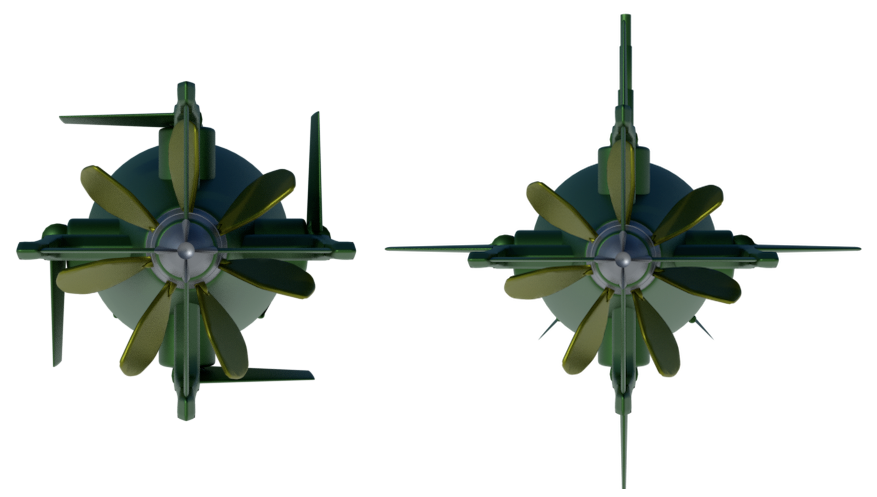The IRIN/IRGCN Azhdar UUV

The following intelligence report is a work of FICINT (fiction intelligence). It details the development of an indigenous Iranian UUV, the Azhdar, and is based on an alternative history published with Divergent Options in October of last year.
|SUMMARY|
On the morning of May 12, 2019, four oil tankers - two Saudi, one Norwegian, and one UAE - were attacked while anchored off the Port of Fujairah, UAE.
-
An official investigation concluded that the attacks were carried out by an anonymous "state actor" using limpet mines placed by divers or fast boat operatives.
-
According to Reuters, Norwegian insurer DNK concluded that the attack was carried out by Iran via the Islamic Revolutionary Guard Corps Navy (IRGCN), and that it "was likely to have been carried out by a surface vessel operating close by that despatched underwater drones carrying 30-50 kg (65-110 lb) of high-grade explosives to detonate on impact."
-
Classified sources also suggest that an Iranian undersea vehicle was used to carry out the attacks.
We believe that the Fujairah attacks were carried out using an Iranian UUV, the Azhdar ("Dragon").
-
The Azhdar is essentially a mobile mine that can be programmed to detonate at a particular time or place, or when influenced by specific sensory inputs.
-
It can be deployed from surface or subsurface platforms, and is extremely hard to detect and neutralize.
-
Although relatively slow and lumbering when compared to a torpedo or encapsulated torpedo mine, it is extremely quiet and stealthy, and, given its mobility, is largely immune to mine countermeasures.
-
Azhdar undersea deployments would be far more covert than indiscriminate mining, which would take several days of highly visible surface activity.
-
The psychological effect of targeted Azhdar attacks could enable the Iranians to effectively close the Strait of Hormuz while enjoying plausible deniability.
|HISTORY|
Given the IRGCN’s experience with offensive mine warfare, and the fact that the Iranian Revolutionary Guard Corps and IRGCN have historically been skilled early adopters of unmanned technologies, we anticipated that Iran would seek to acquire an offensive unmanned undersea capability through illicit acquisition or indigenous manufacture.
-
Even a crude offensive UUV would provide a considerable asymmetric advantage to Iran and its nonstate proxies operating in the Mediterranean and Bab al-Mandeb Strait.
-
U.S. collection efforts expanded in 2010 to include monitoring for indications of Iranian interest in UUV-related technologies.
-
In 2012, a report surfaced that Iran had managed to domestically produce a UUV, dubbed the Phoenix, that was capable of 18 knots while submerged. Given Tehran’s history of exaggerating or outright fabricating military capabilities, the veracity of this report was questionable.
-
In the months leading up to May 12, 2019, U.S. intelligence became aware of a new indigenous Iranian UUV development program, "AZHDAR," and that Iran had successfully acquired several key unmanned undersea technologies. Nevertheless, we believed that the technical and operational challenges involved in deploying an offensive UUV were too great for Iran to overcome.
|THE VEHICLE|
The Azhdar originated as a repurposed IRIN (Islamic Republic of Iran Navy) e-Ghavasi swimmer delivery vehicle (SDV), a "human torpedo" style of SDV, which, with modifications, is capable of launching from a standard torpedo tube.

Illustration courtesy of Covert Shores.
While we initially believed only a single testbed existed, we now believe that four repurposed e-Ghavasi SDVs were used in the May, 2019 Fujairah attacks, and that the vehicles were launched from an Iranian undersea platform, possibly a Kilo-class submarine or, more likely, two Ghadir-class submarines.

Illustration courtesy of Covert Shores. |
Emboldened by the success of the Fujairah attacks, the Iranians have significantly expanded the Azhdar program, diverting resources from the indigenous Valfajr and Hoot torpedo programs to develop a more advanced version of the vehicle. The result is a mobile, stealthy, highly lethal weapon that will be highly effective in Iranian gray zone operations, and could hold U.S. warships at risk during a full-scale conflict.

Azhdar side view, recessed.

Azhdar side view, control surfaces, handling lugs, modem, bilge keel, and communications mast deployed.
The Azhdar is essentially a semi-autonomous mobile mine (or low-speed torpedo) that can be programmed to detonate at a particular time or place, or when influenced by sensory inputs.
-
It can be deployed from surface or subsurface platforms, and is extremely hard, if not impossible, to detect and neutralize.
-
Azhdars could also be launched from surface platforms, loitering for as long as 24 hours near shipping lanes or ports.
-
Although slow and lumbering when compared to a conventional torpedo or encapsulated torpedo mine, it is extremely quiet and stealthy, and, given its mobility, is largely immune to mine countermeasures.
-
The Azhdar may also be capable of seabed deployment, though it would be vulnerable to MCM operations.
-
Azhdar undersea deployments would be far more covert than indiscriminate mining, which requires several days of highly visible surface activity.
-
Like Iranian torpedos or EM-52 multi-influence rising mines, the vehicle can accommodate approximately 450lbs of high-yield explosive, enough to cause signifcant damage to a commercial vessel or armored warship.
The Azhdar poses a unique tactical challenge for the U.S. Navy, potentially blunting conventional mine countermeasures and anti-submarine warfare (ASW) capabilities.
-
Consistent with expected Iranian submarine tactics, we believe that Azhdars could be deployed from Ghadir-class midget submarines operating on the seabed in shallow, cluttered coastal areas where they would be effectively masked from sonar detection.
-
But unlike a torpedo launch, which would expose the Ghadir to near-immediate counter-detection and counterattack by U.S. ASW assets, an Azhdar launch would be extremely difficult if not impossible to detect.
-
Once deployed, the Azhdar would proceed slowly and quietly, approaching its target without warning and detonating on contact, or from magnetic influence.
|CONSTRUCTION|
The Azhdar is 8 meters long and 533mm in diameter, making it compatible with standard torpedo tubes. The vehicle’s forward diving planes, bilge keel, coms/sensor masts, and handling lugs are recessed into the hull and spring loaded to deploy upon launch.

The rear stabilizers are designed to unfold on launch in a manner similar to a TOW anti-tank or Tomahawk cruise missile.


SPECIFICATIONS
Length: 8 meters
Max width with unfolded rudders: 0.9 m
Max height with mast deployed: 1.76 m
Mast length: 1 m
Surfaced weight: 1586 Kg
Submerged weight: 1745 Kg
Maximum Speed: 22 Knots
Endurance:
|Active (20 knots) - 20 hours
|Patrol (9 knots) - 24 hours
|Standby - 96 hours
Range (Active): 127 km
Propulsion: 1x 20 KW Electric motor
|POWER & PROPULSION|
By integrating propulsion technologies from the Valfajr and Hoot torpedo programs, the Azhdar is capable of reaching speeds of 18-25 knots, enabling it to pursue and strike moving, as well as stationary, targets such as transiting commercial shipping vessels and warships. A Li-Ion provides 50 volts of power, enabling approximately 20 hours of endurance and 127 km range when in Active mode.
 AZHDAR POWER & PROPULSION: 1. Battery control unit. 2. Power supply. 3. Li-Ion Battery cell. 4. Capacitor bank for power management unit. 5. Battery retainer structure. 6. Electric motor. 7. Propeller drive shaft.
AZHDAR POWER & PROPULSION: 1. Battery control unit. 2. Power supply. 3. Li-Ion Battery cell. 4. Capacitor bank for power management unit. 5. Battery retainer structure. 6. Electric motor. 7. Propeller drive shaft.
|
|SENSORS & COMMUNICATIONS|
Iran leverages a robust network of shell companies and intermediaries to acquire a range of COTS unmanned undersea technologies, such as accelerometers and gyroscopes (used in inertial guidance systems), marine magnetometers, electro-hydraulic pressure sensors, and underwater modems. Iran has also harvested sensor technologies from its sizeable inventory of floating, moored, and bottom mines, successfully integrating them with the onboard processor and the vehicle's warhead.
 AZHDAR SENSORS & COMMUNICATIONS: 1. Sonar array processor. 2. Sonar array. 3. Data-bus and power supply. 4. Magnetic sensor processor 5. Magnetic sensor array. 6. Navigational sonar array. 7. Radar transmitter and main sensor processing block. 8. Hydraulic reservoir for mast.
AZHDAR SENSORS & COMMUNICATIONS: 1. Sonar array processor. 2. Sonar array. 3. Data-bus and power supply. 4. Magnetic sensor processor 5. Magnetic sensor array. 6. Navigational sonar array. 7. Radar transmitter and main sensor processing block. 8. Hydraulic reservoir for mast.
|
|C3I|
Iranian smuggling networks have also succeeded in acquiring COTS computers and advanced signal processing technologies, and on several occasions have acquired whole vehicles, successfully reverse engineering and harvesting them for critical systems and parts.
 AZHDAR C3I: 1. FWD ballast tank. 2. Forward fin actuator. 3. Forward fin recess. 4. FWD ballast blow gas generator. 5.Control computer/autopilot block. 6. Underwater modem. 7. Inertial Measurement Unit (IMU). 8. Propulsion control unit. 9. AFT ballast blow gas generator. 10. AFT ballast tank. 11. Rear fin control actuator.
AZHDAR C3I: 1. FWD ballast tank. 2. Forward fin actuator. 3. Forward fin recess. 4. FWD ballast blow gas generator. 5.Control computer/autopilot block. 6. Underwater modem. 7. Inertial Measurement Unit (IMU). 8. Propulsion control unit. 9. AFT ballast blow gas generator. 10. AFT ballast tank. 11. Rear fin control actuator.
|
|CONCLUSION|
The Azhdar is a force multiplier for the IRGCN, combining the sea denial capability of conventional offensive mine warfare with the stealth, mobility, and plausible deniability of unmanned undersea operations. It is a game-changer for Iranian seapower, with far-reaching implications for the United States and its regional allies.

